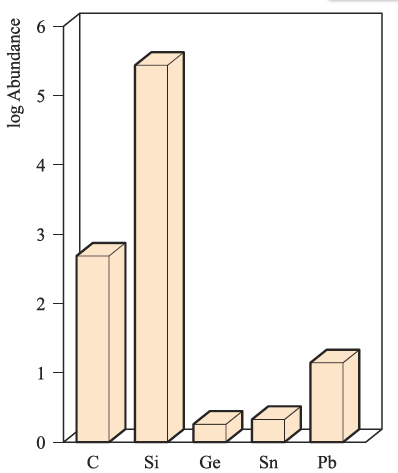
Occurrence, extraction and uses Occurrence of group 14 elements
 المؤلف:
CATHERINE E. HOUSECROFT AND ALAN G. SHARPE
المؤلف:
CATHERINE E. HOUSECROFT AND ALAN G. SHARPE
 المصدر:
INORGANIC CHEMISTRY
المصدر:
INORGANIC CHEMISTRY
 الجزء والصفحة:
2th ed p 338
الجزء والصفحة:
2th ed p 338
 23-3-2017
23-3-2017
 2102
2102
Occurrence, extraction and uses Occurrence of group 14 elements
Figure 1.1 illustrates the relative abundances of the group 14 elements in the Earth’s crust. The two long-established crystalline allotropes of carbon, diamond and graphite, occur naturally, as does amorphous carbon (e.g. in coal).
Diamonds occur in igneous rocks (e.g. in the Kimberley volcanic pipes, South Africa). Carbon dioxide constitutes only 0.04% of the Earth’s atmosphere, and, although vital for photosynthesis, CO2 is not a major source of carbon.
During the 1990s, it was discovered that molecular allotropes of carbon, the fullerenes (see Section 13.4), occur naturally in a number of deposits in Australia, New Zealand and North America; however, laboratory synthesis remains the chief means of accessing these new allotropes. Elemental Si does not occur naturally, but it constitutes 25.7% of the Earth’s crust (Si is the second most abundant element after O) in the form of sand, quartz, rock crystal, flint, agate and silicate minerals . In contrast, Ge makes up only 1.8 ppm of the Earth’s crust, being present in trace amounts in a range of minerals (e.g. zinc ores) and in coal. The principal tin-bearing ore is cassiterite (SnO2). Important ores of lead are galena (PbS), anglesite (PbSO4) and cerussite (PbCO3).

Fig. 1.1 Relative abundances of the group 14 elements in the Earth’s crust. The data are plotted on a logarithmic scale. The units of abundance are parts per million (ppm).
 الاكثر قراءة في مواضيع عامة في الكيمياء اللاعضوية
الاكثر قراءة في مواضيع عامة في الكيمياء اللاعضوية
 اخر الاخبار
اخر الاخبار
اخبار العتبة العباسية المقدسة


